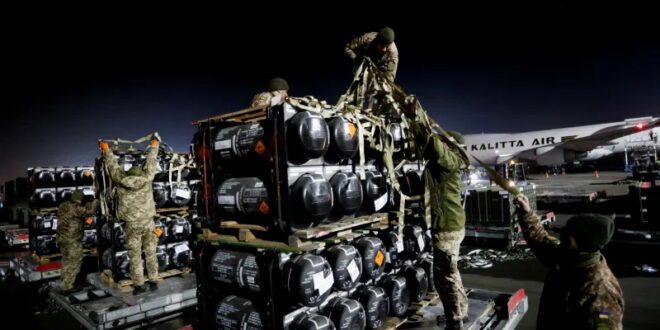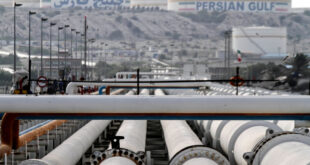The U.S. Military Needs Low-Cost Innovation—Not Big-Ticket Boondoggles
It is ironic that, despite two decades of U.S.-led conflict in Afghanistan and Iraq, it took just a few months of Russia’s war in Ukraine to finally draw attention to the depleted state of U.S. weapons stocks and the vulnerabilities in U.S. military supply chains. In recent months, American military leaders have expressed increasing frustration with the defense industrial base. As the U.S. Navy’s top officer, Admiral Mike Gilday, told Defense News in January, “Not only am I trying to fill magazines with weapons, but I’m trying to put U.S. production lines at their maximum level right now and to try and maintain that set of headlights in subsequent budgets so that we continue to produce those weapons.” The fighting in Ukraine, Gilday noted, has made it clear to military leaders “that the expenditure of those high-end weapons in conflict could be higher than we estimated.”
Tellingly, just 100 days after the United States approved the transfer of Javelin and Stinger missiles to Ukraine, the missile manufacturers Raytheon and Lockheed-Martin warned that it could take years to restore their stocks to pre-invasion levels. As the war drags on, the United States will face not only production line challenges but also difficulties gaining access to semiconductors and raw resources such as cobalt, neon, and lithium—elements that are essential to the manufacture of modern military technology and that China increasingly controls. The United States will have to develop the means to sustain its current weapons arsenals without sacrificing the resources it will need to research and develop next-generation platforms and munitions.
Since the end of the Cold War, the Pentagon has invested in technology that limits casualties but does not decrease the cost of manpower. It has spent heavily on expensive and scarce technologies for first-strike offensives, largely ignoring the effect of such expenditures on its ability to fund wars and to secure supply chains. Thirty years into this technological push, the United States lacks the technology and resources to maintain support for Ukraine at present levels, much less to deter China from invading Taiwan.
Now that these weaknesses have been revealed, they deserve serious attention. The difficulties the United States has faced in meeting Ukraine’s weapons needs hint at the far greater challenges Washington would likely confront in maintaining its edge in a war fought with more cutting-edge battlefield technologies. A clear understanding of the historical relationship between technological change and war suggests that the United States should urgently prioritize technology that reduces not just the political costs but also the economic costs of war.
SEEKING AN EDGE
War is the ultimate contest of human will. At its crudest, it is a lethal competition for power and survival in which the weak are destroyed and the strong persevere. But although warfare may fundamentally be a contest of human strength, it is also human nature to seek a technological edge over an opponent in order to shift the balance of power.
The Old Testament book of Samuel recounts how David used a slingshot and a well-aimed stone to defeat the Philistine giant Goliath. During the Hundred Years’ War, the invention of the English longbow gave England an advantage over France. Stealth aircraft developed by the United States at the end of the twentieth century were used to great effect during the “shock and awe” phase of the 2003 U.S. invasion of Iraq. With arrows or with aircraft, military planners have always sought new technology to give them an edge over their enemies on the battlefield.
Nevertheless, states often struggle to translate battlefield technological advantages into strategic victories. For example, Germany’s development of blitzkrieg in the 1930s represented a revolution in mechanized maneuver warfare, yet the technique wasn’t enough to allow Germany to hold territory once American materiel and manpower were committed to retaking Europe. In Afghanistan, a high-tech U.S. military with remotely piloted aircraft, precision munitions, and satellite intelligence could not outlast a persistent Taliban.
For technology to influence who ultimately wins or loses, it cannot create merely temporary changes on the battlefield. Instead, it must buttress the human will to sustain conflict over time by fundamentally altering the cost of warfare. Having the right technology for battlefield effectiveness is necessary. But absent a focus on how these technologies affect the long-term cost, be it political or economic, the right tools alone are not sufficient for strategic success. To achieve victory, a government must have both the economic power to finance conflicts and the political control to raise funds and mobilize its citizenry. The economic costs of warfare create political costs when a government levies taxes or institutes universal conscription to maintain a conflict. New technologies become a revolutionary advantage in war when, as the military historians Williamson Murray and MacGregor Knox explain, “they alter the capacity of states to create and project military power.”
With arrows or aircraft, military planners have always sought technology to give them an edge over their enemies.
Technology can do this in myriad ways. First, technology can create greater firepower to increase the cost in terms of life and limb; think of artillery, firebombing, or nuclear weapons. These high-firepower technologies open the way for a strategic victory by creating a high enough human cost that an adversary capitulates, either because it no longer has the military manpower or because civilian casualties erode political will. Alternatively, technology can decrease the human cost of war by limiting losses and making escalation less likely, thus preserving manpower and bolstering political will. This was a theme of U.S. technological investment after the 1990–91 Gulf War, when new tools such as long-range precision-guided munitions helped keep U.S. casualties low during decades of sustained conflict in the greater Middle East.
Technology that changes the human cost of warfare has a secondary economic effect by changing the price of arming, training, and replenishing forces. The development of the longbow, for example, decreased the economic and political cost of warfare by allowing the English monarchy to replace knights with archers. Archers were commoners, requiring a tenth of the pay of noble knights, and their equipment—arrows, bows, swords—was far cheaper to provide than knights’ armor and horses. Monarchs could afford a much larger army with the same budget, allowing more wars of conquest without levying new taxes on the landed elite, which risked turning them against the crown.
Technology also changes the cost of engagement, shifting the balance between offense and defense. Perhaps the best historical example is the Renaissance-era competition between sieges and fortifications. In fifteenth- and sixteenth-century Europe, advances in metallurgy and gunpowder increased the firepower of attackers. At the same time, however, innovations in fortifications (such as the trace italienne, a type of polygonal fortress that was developed to protect soldiers from cannon fire) made it increasingly costly and arduous for attackers to succeed. As Giovanni Botero, an Italian political theorist of the era, noted, the winners in this contest were those who were able “not to smash but to tire; not to defeat but to wear down the enemy.” The result, Botero wrote, was a form of warfare “entirely dependent on money.”
More generally, technology affects a state’s ability to fund wars and to supply the battlefield. It can do this by enabling powerful war economies or by revolutionizing the creation and production of weapons—and ideally by doing both. During the Industrial Revolution, machine manufacturing and steam engines enabled mechanized warfare and the production of mass arsenals. Railroad investments facilitated economic expansion while also decreasing the cost of mobilizing large armies, allowing states such as Prussia to rely on a rapidly deployed reserve force instead of maintaining a costly standing army.
Finally, technology can decrease resource dependencies so that states can control supply chains and sustain their ability to carry out a conflict over time. For example, late-eighteenth-century French innovations in gunpowder manufacturing allowed the French to supply American colonies with enough materiel to outlast the resource-rich British empire.
BLINDED BY VICTORY
Many of these historical lessons about technology and the cost of warfare were overlooked by the post–Cold War U.S. military, which was temporarily blinded by the overwhelming victory that technology allowed in the 1990–91 war against Iraq. American decision-makers believed that advances in computing, stealth technology, and sensors could allow a smaller, high-tech U.S. military to avoid large and costly wars of attrition and thereby preserve the political will to support a post-Vietnam all-volunteer force.
“The new American way of war,” as the writer Max Boot termed the approach, focused on what military planners called “effects-based operations” that offered quick, overwhelming victories. In this view, advanced technology would make wars shorter, more decisive, and less bloody. No longer concerned about the costs of sustaining wars of attrition, the United States could focus its resources on a leaner, higher-quality force.
The transformation of the U.S. military to a smaller, more high-tech arsenal was Donald Rumsfeld’s focus when he took over as secretary of defense in 2001. But the 9/11 attacks and subsequent U.S. invasions of Afghanistan and Iraq muddled the logic behind the transformative theory of technological victory.
While insurgents produced cheap IEDs, the U.S. launched $150,000 missiles from $30 million drones.
The United States was still fighting high-tech, expensive wars, but it was doing so over two decades and at a cost of over $10 trillion. Whereas insurgents produced cheap improvised explosive devices, rocket-propelled grenades, and mortars, the United States launched $150,000 Hellfire missiles from $30 million remotely piloted drones, dropped $25,000 precision munitions from $75 million stealth aircraft and spent $45 billion on a phalanx of armored personnel carriers—linking all these systems with satellites at the cost of hundreds of millions to billions of dollars. And even as the number of U.S. military members shrank, the average cost per service member for the transformed elite all-volunteer force rose by more than 60 percent between 2000 and 2012. War was indeed less bloody than before, but it didn’t come on the cheap, nor did victory come quickly or decisively.
Meanwhile, Chinese advances in electromagnetic warfare, artificial intelligence, stealth, propulsion, space, and precision munitions quickly eroded Washington’s initial information-age technological lead. It was not just that China was a fast follower; the United States was also stumbling. The Pentagon’s sclerotic process for acquiring new technology, bureaucratic complacency, and constant desire for “the next big thing” meant that each technological iteration took longer and came at greater cost. The U.S. Navy’s Zumwalt-class destroyer program, for example, promised 32 stealth destroyers with revolutionary advances in guns, propulsion, and networks. Instead, after spending over $22 billion, technological cost overruns forced the navy to cut the program to a mere three destroyers, all of which have been plagued by maintenance problems. No one meant to buy three destroyers for $22 billion. Instead, the military had ended up in a paradox: chasing emerging technologies had made weapons so expensive that no qualitative upgrade could make up for the decline in in quantity, leaving the Pentagon with an arsenal that was neither good enough nor large enough for the campaigns it planned to fight. Similarly, in a damning 2021 indictment, the Government Accountability Office projected a $6 billion cost overrun for the F-35 fifth-generation fighter program, warning that the military must reduce either the total number of aircraft it planned to purchase or the number of flying hours anticipated for them.
The United States also underprioritized technology that would rein in the cost of logistics, maintenance, and replenishment, opting instead for high-tech weaponry patched together with fragile and outdated software. This led to a series of ambitious but failed programs—for example, the $20 billion Army Future Combat Systems—that faltered as the military ignored the support technology needed to operate next-generation weapons platforms. The lack of investment in support technology also exacerbated problems with manpower, training, and readiness that had begun to surface after two decades of sustained conflict. This came to a head for the navy starting in 2017, when a series of ship collisions and maintenance issues highlighted the service’s struggle to man and train surface fleets equipped with “overly complex” technology.
Now, as the United States pivots to Asia while resupplying Ukraine, it is still mired in expensive acquisition programs for exquisite new bombers, submarines, and next-generation fighters. As it embarks on developing military-wide networks to bring all these weapons together, it has little more to show for itself than billions of dollars of PowerPoint presentations.
LOWER-COST ALTERNATIVES
Washington urgently needs to prioritize technology that will curb the economic cost of U.S. warfare. The first step is to acknowledge that it is not realistic for the United States to replace all of its expensive existing systems with cheap, off-the-shelf technology, as some observers have advocated. Many of these high-end systems play important roles in combating U.S. rivals such as China. Instead, the United States should complement complex, high-cost technology with cheaper autonomous sensors, communications relays, munitions, and decoys—all designed to create friction, slow conflict, and increase the long-term costs to adversaries. Simultaneous investments in resilient networks, adaptable information technology, and munitions stockpiles will create a resilience that also increases U.S. deterrence credibility after the initial salvos of war. The United States will also need to cut the administrative cost of technology by reforming bureaucracy, using the savings to invest in defense industrial capacity and access to raw resources for emerging technology. Such efforts will be difficult at a time of high inflation and political polarization, but they are necessary. Technology must decrease not only the human cost of war for the American public but also the economic toll.
None of these predicaments are new. In 1553, the Republic of Siena began constructing a new fortification so ambitious and costly that when Florentine troops invaded a year later, Siena was only partly fortified and financially destitute, with no money left to raise an army. Poor decisions in managing cost and technology doomed the city-state. More recently, U.S. President Ronald Reagan’s Strategic Defense Initiative (a high-tech plan to shoot down ballistic missiles with airborne lasers) is credited with bankrupting the Soviets as they struggled to compete with what turned out to be a technically infeasible effort.
To avoid becoming Siena (or the Soviet Union), Washington must remember that having the right technology is necessary but insufficient to win wars. If the United States hopes to persevere against Russia in the short term and China in the long term, it must consider the economic impact of technology even as it pursues a technological advantage.
 Eurasia Press & News
Eurasia Press & News




